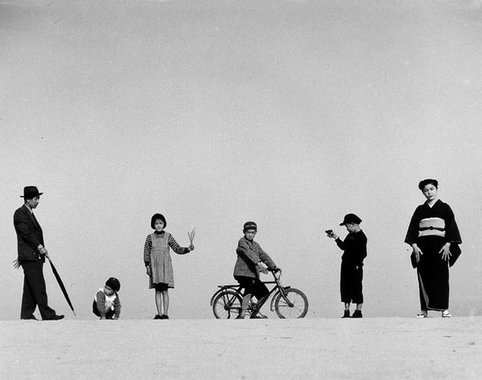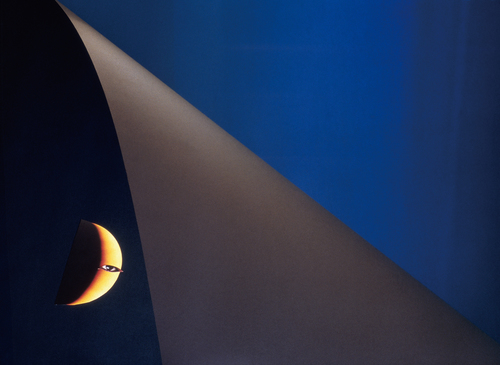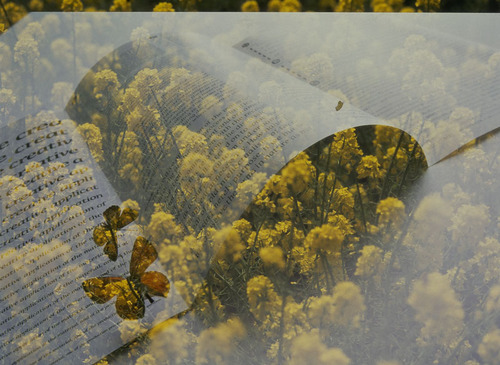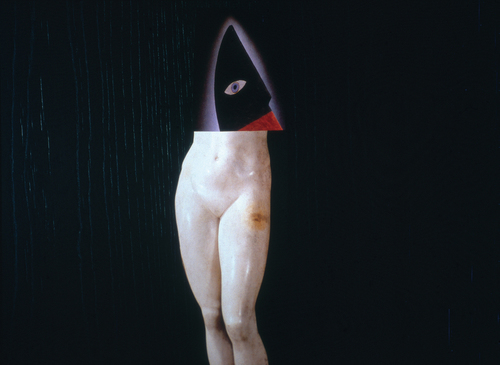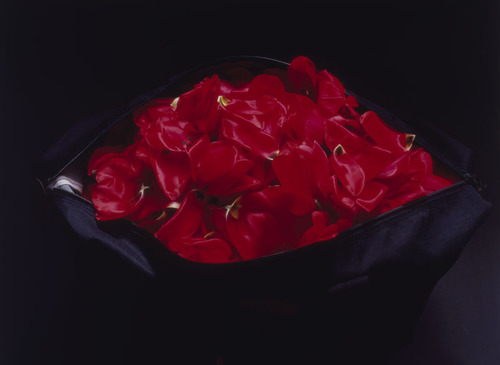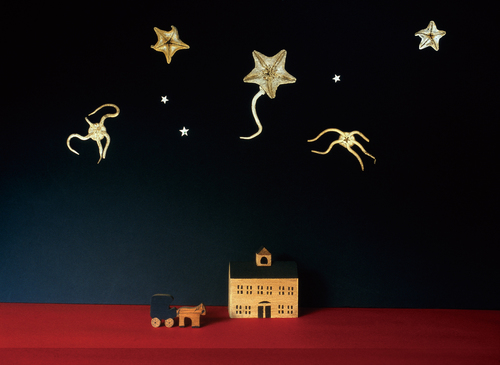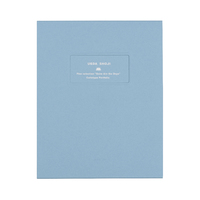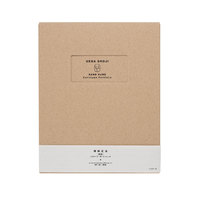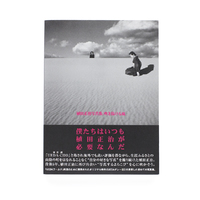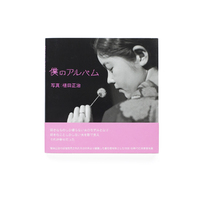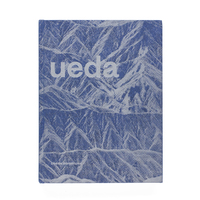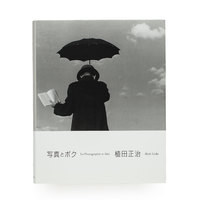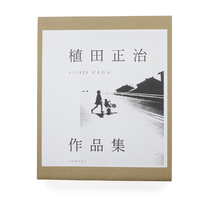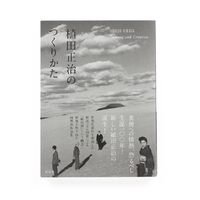Shoji UEDA
植田正治
Born 27th March Sakaimachi, (now known as Sakaiminato City), Shoji Ueda was the third and only surviving child of four children. Born and raised in Tottori prefecture, Ueda's photographic works are both playful and meticulous constructions which depict an array of surreal and dreamlike landcapes shot against the backdrop of Tottori Sand Dunes.
A master photographer, Shoji Ueda's works are beautiful and elaborate realizations of a worldview, which remained unique and stood apart amongst the iconic developments of 1960s Japan, such as the politically radical Provoke movement.
Chronology
1919 - Ueda entered Sakaimachi Elementary School.
1922 - Ueda in grade-school was fond of language class and was often assigned to recite textbooks, but was not good at mathematics. In the third grade, he first used crayons, which led him to enjoy drawing classes.
1923 - Ueda found that a neighbor, a young man, was printing photographs in his living room converted into a dark room by covering a light with a red cloth. Ueda was extremely attracted to the process in which an image came up from a blank paper.
1924 - He became a fan of illustrators whose works were published in boy’s magazines such as Shonen Club (Boy’s Club), Shonen Sekai (Boy’s World) and Nihon Shonen (Japanese Boys). His heroes were Kasho Takabatake, Shokichiro Yamaguchi, and Hikozo Ito. Ueda especially liked Kasho’s illustrations.
1925 - Ueda entered Tottori Yonago Junior High School.
1928 - As his interest in photography became more intense, he could not stop expressing it all the time. Once he was scolded by his teacher when reading a photo magazine during class. Ueda bought a ceramic plate for developing vest-pocket size prints. One day Ueda’s father found his son was absorbed in contact printing from 4.5x6cm plate in a kitchen closet, and gave him a severe scolding, saying that do not indulge in such a ‘hobby.’
1929 - Ueda’s father came to understand his son’s serious interest in photography and bought him his first camera (4.5x6cm format, Japanese product).
1930 - Ueda intended to go to an art school in Tokyo to become an oil painter, but the idea was objected by his parents because Ueda was the only son to succeed his family business. Instead, the parents bought him a high-class camera, Piccolette with a fixed F4.5 Tessar lens (4.5x6cm format).
1931 - Graduating from Tottori Prefectural Yonago Public High School, Ueda became more involved with photography, joining Yonago Shayukai (Yonago Photography Circle). Around that time, a special issue of The Studio magazine titled Modern Photography (fall, 1931) containing many European avant-garde photos was a strong stimulus. A Boy on the Beach received the monthly award of Camera magazine (December issue), which was the first prize of Ueda’s career.
1932 - At the photo studio of Mimatsu Department Store in Hibiya, Tokyo, Ueda received photography training. Later he was enrolled at the Oriental School of Photography for three months. After his return to Tottori, he opened his own photo studio. In August, Suidobashi Landscape won a special commendation at the Nihon Koga Kyokai (Japan Photographic Society) Exhibition at Karasuma Chamber of Commerce, Kyoto, which led Ueda to join the association. The award-winning photo was taken during his stay in Tokyo.
1933 - Ueda was instrumental in the founding of a local photographers circle in Tottori, the Nihonkai Club (Japan Sea Club). He began to enthusiastically enter into monthly contests of photographic magazines such as Asahi Camera and Photographic Salon.
1935 - Ueda married Norie Shiraishi. Norie’s strong support allowed Ueda to concentrate harder on his photography.
1936 - Ueda worked on a series using back-lighting effects. Silhouette, taken with this technique, won first prize (third rank) of the Special Anniversary Awards of the magazine, Photographic Salon (Special Enlarged Issue, June).
1937 - In February, invited by Ryosuke Isizu, Ueda became one of the founding members of the Chugoku Shashinka Shudan (Chugoku Photographers Group). The group held annual exhibitions in at Konishiroku Hall in Tokyo for four years until 1940.
Hiroshi, the first son of Ueda, is born.
1938 - Kazuko, Ueda’s first daughter, is born.
1939 - In September, Ueda presented his first art-directing photo, Four Girls in the third exhibition of the Chugoku Photographers Group. In December, it received a special prize at the 13th Exhibition of the Japanese Photographs hosted by Mainichi Newspapers (Ginza Mitsukoshi Department Store, Tokyo).
1940 - Mitsuru, Ueda’s second son, is born.
1943 - As WWⅡ took an ever greater toll on people’s lives, Ueda was conscripted for military service at the Hikari Navy Yard in Yamaguchi Pref., but was immediately sent back to his hometown due to malnutrition. On later occasion, he was again called up but returned on the same day, as had happened once in 1938.
1944 - Toru, Ueda’s third son, is born.
1945 - After the end of the war in the summer, Ueda came across an article in the Osaka Asahi Shimbun (Osaka Asahi Newspaper)that December announcing a public contest by the Asahi Shashin Tenrankai (Asahi Photograph Exhibition), which made him feel for the first time since the war that he was returning to life as a photographer.
1947 - Ueda joined Ginryusha, a photographers group, together with Yoichi Midorikawa.
1949 - Ueda, Ken Domon and Yoichi Midorikawa participated in a competitive photo session at Tottori Sand Dunes in an editorial project conceived by Kineo Kuwabara , then the editor in chief of Camera, which was covered in the September issue of the magazine. Ueda’s photo series, My Family, was also featured in its October issue.
1950 - Around this time, the Etan-ha (Etan school) was formed by Ueda and young photographers from the San-in region who had been meeting at Ueda’s house.
1951 - In autumn, Ueda did his first nude photo shoot at the Tottori Sand Dunes.
1952 - Ueda took photos of Japanese folk handicraft implements and compiled them in Series
Publications
1962 - ”San-in no tabi” (Travels in San-in)、
Tokyo: publishing department of ShakaiShisoKenkyukai Research Institute of Social Thought、Japan
1965 - "Camera Kiko: Izumu no Shinwa (the Legend of Izumo: A photographic Travelogue), Tankosha, Japan
1967 - Oki, Takosha
1971 - "Warabegoyomi (Children the Year Round)",
the third volume of Eizo no gendai (The Present of Images), Koronsha, Tokyo
1971 - Co-authored with Takatoshi Ishizuka,"Izumo-jiRyojo(Heart of Travelers in Izumo)", Shimbunsa, Toko
1974 - "Ueda Shoji shoryokoshashincho–Oto no naiKioku
(Ueda Shoji Sketch Album - Memories without sound)", Nihon Camera-sha
1974 - Co-authored with Masaaki Ueda, "Izumo", Mainichi Newspapers, Tokyo
1974 - Co-authored with Yoshiaki Tono, "IzumoTaisha(Izumo Shrine)", Heibonsha, Tokyo
2015 - Shoji Ueda, Chose Commune, France
Selected Solo Exhibitions
Konishiroku Hall, Tokyo, Japan (December)
First Exhibition of the Chugoku ShashinkaShudan (Chugoku Photographers Group)
Entered May Child
1938
Konishiroku Hall, Tokyo, Japan (May)
Second Exhibition of the Chugoku ShashinkaShudan
Entered People in Snow and other works.
1939
Konishiroku Hall, Tokyo, Japan (September)
Third Exhibition of the Chugoku ShashinkaShudan
Entered Four Girls, Children, and Spring
Ginza Mitsukoshi, Tokyo, Japan (December)
13th Japanese Photographic Art Exhibition (sponsored by Mainichi Newspapers)
Four Girls was awarded a special commendation.
1940
Konishiroku Hall, Tokyo, Japan (June)
Fourth Exhibition of the Chugoku ShashinkaShudan
Entered Old Chatani and his Daughter and other works.
1946
Daimaru Department Store, Osaka (February) and other locations in Japan
Asahi ShashinTenrankai (Asahi Photograph Exhibition)
Ueda’s first work after the war, Infant, won a special commendation.
1957
Fuji Photo Salon, Tokyo, Japan (September)
Six Photographers Exhibition
1958
The Museum of Modern Art, NY, U.S.A.
Photography in Retrospect (curated by Edward Steichen)
November, 1958-January, 1959
Surface of Snow is added to MoMA’s photograph collections.
1969
Pentax Gallery, Tokyo, Japan (October)
San-in Twelve Photographers (joint exhibition with amateur photographers from San-in region)
This exhibition was held annually until 1973.
1974
Nikon Salon, Tokyo (Ginza and Shinjuku) and Osaka
Ueda Shoji: Photographs, 1935-1974
1979
GALLERIA D’ARTE MODERNA BOLOGNA, Bologna, Italy (January-February)
PhotografiaGiapponesedal 1848 ad Oggi
1980
Nikon Salon, Tokyo (Ginza and Shinjuku), Osaka and other areas in Japan
Vision of Landscape
1982
17thPhotokina, Koln, Germany (October)
38 JAPANESE PHOTOGRAPHS
1984
Pentax Forum, Tokyo (January)
Fifty Years of Photography of Ueda Shoji
1986
Centre Pompidou, Paris, France (December, 1986-March, 1987)
Japon des avant gardes, 1910-1970: exposition
1987
Parco Shibuya, Tokyo, Japan (February)
Dunes – Ueda Shoji Exhibition
1988
Houston Center, Texas, USA (February)
Photo Fest ’88 Invited as guest artist.
1990
KonicaPlaza, Tokyo, Japan (March-April)
The Story of Landscape and Still-life
1992
YonagoCityMuseum of Art, Tottori, Japan (February-March)
Ueda Shoji and his Colleagues: 1935-55
JCII Photo Salon, Tokyo, Japan (July)
Dune Theater
1993
Tokyo Station Gallery, Tokyo, Japan (July-August)
Shoji Ueda
1994
La Galerie Municipale du Château d'Eau, Toulouse, France (December)
Shoji Ueda
Solo exhibition of his representative works.
2001
Matsuya Department Store, Ginza, Tokyo, Japan (January)
Tokyo Metropolitan Museum of Photography, Japan (August-September)
GANJIN (Jianzhen and photographers around the World – Commemorating the Heisei Repairs of the Main Hall of Toshodai-ji Temple)
Posthumous exhibition of Ueda’s last work, Black Wave
Ueda planned to visit Toshodaiji on the following day of his death.
Kulturhuset, Stockholm, Sweden (August-September)
Illusion - Japanese Photography
This tribute exhibition to Ueda toured around European countries including Denmark, Norway and Finland until November, 2002.
Awards
(Water in Shadow and Stakes in the Lake)
1978 - Cultural Merit Award on the 10th Anniversary of the Foundation of the Agency
for Cultural Affairsfrom the Japanese Government
1996 - Chevalier des arts et des Lettres from the government of France
1998 - The first Tottori Prefectural Award for Achievements of the Tottori Residents.
